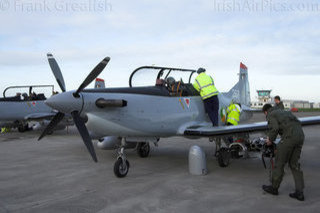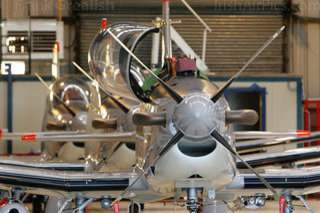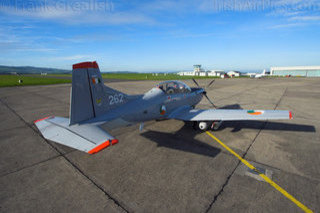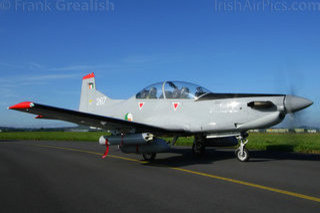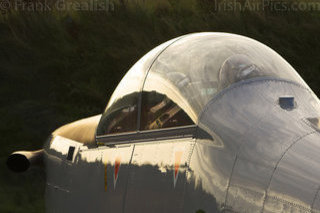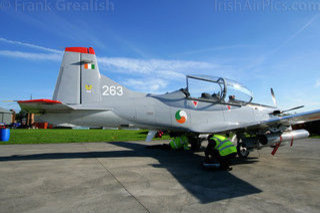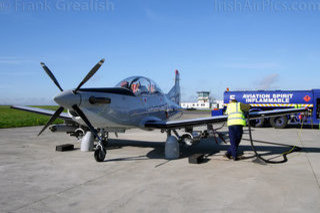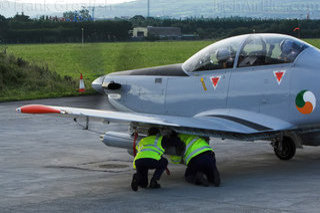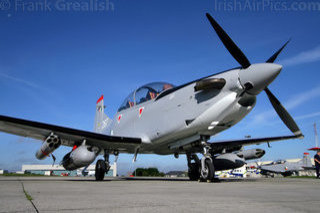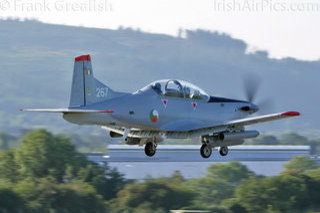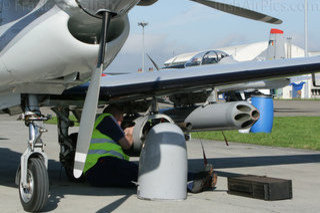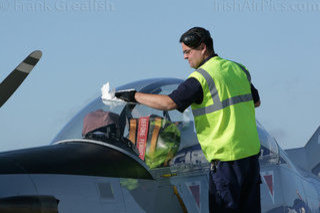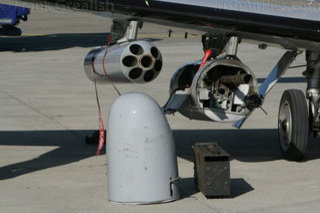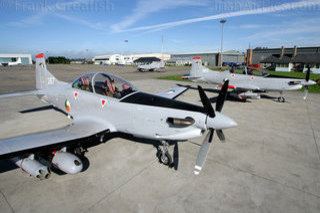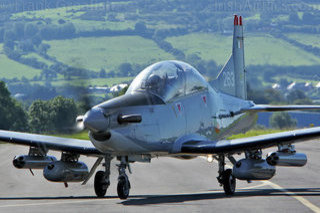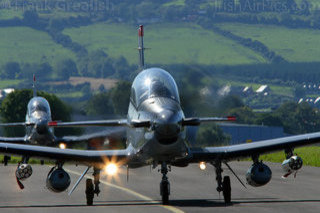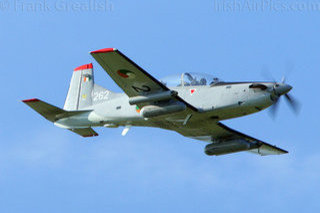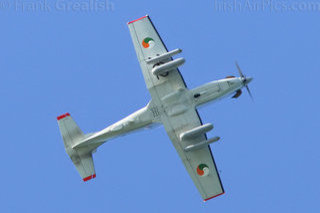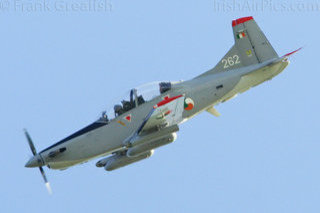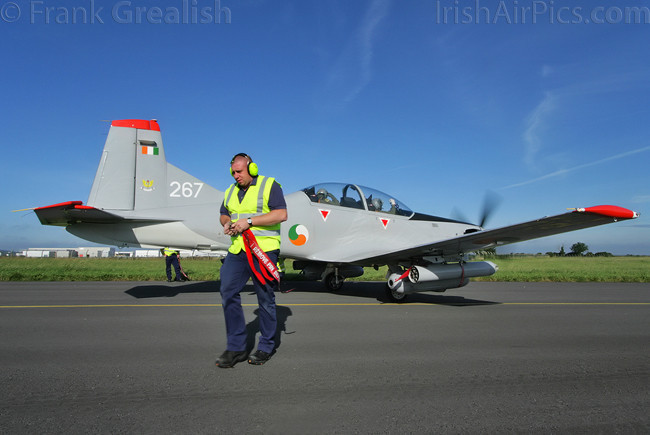
Irish Air Corps PC-9M Air Firing
By: Frank GrealishDate: 20th September 2008
Location: Casement, Baldonnel (EIME), Ireland
Air Corps PC-9Ms put through their paces at Gormanston.
The Air Corps is the air component of the Defence Forces providing a variety of military and non-military air services as set out the White Paper on Defence, which provides the policy context for all Defence Forces operations. In any aviation organisation training is directly linked to the mission; therefore flying training in the Air Corps maintains a military aim, standard and ethos, as its basis. The training strategy of the Air Corps is therefore to train all pilot officers to a military aviation standard sufficient to meet current and potential aviation tasks. A key element of this training is the requirement to maintain a limited clear weather ground attack/support capability. In order to hone such skills, flying instructors from the Air Corps Flying Training School (FTS) carry out their annual air firing recurrency exercises at the D1 air firing range off the coast at Gormanston.
The FTS is equipped with eight turboprop PC-9M aircraft, manufactured by Pilatus Ltd of Switzerland. It's hard to believe that the first three of these aircraft were delivered in April 2004 as part of a €60 million contract. Since then, these light grey aircraft have become a familiar sight at air shows and at ceremonial events across the country. For two weeks last September (16th - 20th and 22nd - 26th inclusive) they were to be seen in the sky above Gormanston military range for their annual air firing training. I was fortunate to be given access to both Baldonnel and Gormanston to view at first hand the activities associated with the air firing exercise.
When air firing exercises are in operation, the pilots and ground crews have an early start, on the occasion of my visit I arrived at Baldonnel at 7.30am and the crews were already busy at work. The pilots have a thorough briefing before each sortie to the range and while this briefing is ongoing the ground crew prepare the aircraft for the mission, this includes fuelling, inspecting and arming the aircraft.
The day started with clear blue skies which given the year we had up to that point was a rare occurrence. This meant that there would be no cancellations due to weather and it also meant that there would be good lighting for photography.
At the start of the day, while the pilots were briefing, the ground crew towed the aircraft from hangar no.1 to a specific area of the ramp that is surrounded by a high earth embankment. As safety is paramount when dealing with live weapons, this area of the ramp ensures that in the unlikely event of something going wrong it is well contained. It is here that the weapons are loaded and made ready for the next mission; the aircraft are also refuelled here. The PC-9Ms are equipped with six underwing hardpoints, four of which are used for these exercises. When weapons are fitted the aircraft are normally configured with two gun pods and two rocket pods per aircraft, thereby utilising four of the six underwing hard points. This is major improvement on the capability of their predecessor the SF-260WE Marchettis which as a very light strike aircraft was unable to deploy rockets and cannon at the same time.
The gun pods used are the HMP250 LCC manufactured by FN Herstal in Belgium. The pod is an is an independent unit housing a lightweight .50 Cal. M3P machine gun and features NATO standard 14in suspension lugs. With a length of 2.05 metres (80.7in) and a width of 410mm (16.1in) each HMP250 can accept up to 250 rounds and features a spent cases and links collector and weighs 116.5 kg (256.93lb) fully loaded. The gun has a rate of fire in excess of 1000 rounds per minute.
The rocket pods used are LAU-7 manufactured by FN, each configured to carry seven 70mm (2.75in) Folding Fin Aerial Rockets (FFAR), with a variety of war heads.
Following the briefing, the pilots were ready to perform a walk around of their aircraft before strapping in. Once the aircraft are started and ready to fly the ground crew, who are in contact with the pilot via an intercom plugged into the wing, remove all remaining safety pins from the pods mounted under the wings. While the pins are being removed the pilots hold both hands where they are visible to the ground crew, this is to ensure that no button, switch or control is inadvertently touched while the ground crew are under the aircraft.
Once all checks are completed and all pins have been removed the aircraft departed Baldonnel and arrived a few minutes later over the range at Gormanston some 20 nautical miles away. The range at Gormanston is also crewed by Air Corps personnel while all air firing is being carried out, a Naval Service vessel is also present, this ensures that the beach where the targets are placed and the surrounding land and water are clear of people and vessels. The Department of Transport publishes an exclusion zone comprising the lands of Gormanston Aerodrome itself and the air and sea areas within a radius of three nautical miles centred on the field with an additional area contained within a segment centred on the field and bearing of 015° degrees true, through Mosney Railway Station and 106° degrees true, through Gormanston Railway Station seawards for a distance of 10 nautical miles. Live firing will not commence until the danger area is clear and the officer in charge of the range gives permission to commence firing runs.
The actual firing sorties are very similar to that described by Mick Bevan in his "Memories of the Marchettis" article which appeared in our October issue (Issue 10, Volume 4) although the state of the art technology on the PC-9M such as the sophisticated computer generated 'Head-Up Display (HUD)' system allows aircrew perform very accurate automatic target engagement.
While I was present at Gormanston, the aircraft performed multiple runs at the target at various heights and attack angles; the exact attack profiles flown depend on which weapon is being used and the desired training objective of that sortie. All weapons are fired from an easterly heading towards the sea with the aircraft turning in to the target overhead Gormanston Army Camp. The Air Corps used to have a base here but they have long since consolidated operations at Baldonnel although the Air Accident Investigation Unit, a civilian organisation, still has the use of a hangar there.
Once the firing sortie is completed the aircraft return to Baldonnel. As soon as the aircraft land, they turn off the runway and wait on a taxiway making sure that they are pointing away from any buildings, again, for safety reasons, which is of paramount importance. The aircraft are followed along the runway by ground crew who replace all safety pins before the aircraft are cleared to return to the ramp. Here again, as happened before the aircraft departed, the pilots hold their hands in a position that is visible to the ground crews to ensure ground crew safety while they are underneath the aircraft.
Once the aircraft return to the ramp, the pilot shuts down and hands the aircraft back to the ground crew to be turned around for the next sortie. The gun pods are opened and the spent shell casings checked for any live rounds before being disposed of. The guns themselves are given the once over to make sure all are still serviceable for the next mission. Any snags that arose during the mission are dealt with, the aircraft are refuelled, weapons loaded and prepared for the next sortie. While all this is taking place, the pilots who flew the previous mission are debriefed and pilots for the next mission are briefed. Once the aircraft and pilots are ready the cycle begins all over again and another sortie is flown. Once again the Air Corps demonstrated a high level of professionalism both on the ground and in the air maintaining the highest standards developed through rigorous training and procedures.
My sincere thanks go to all the personnel of the Air Corps who provided help, assistance and support during my visit to Baldonnel & Gormanston

